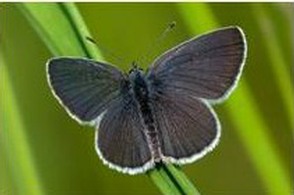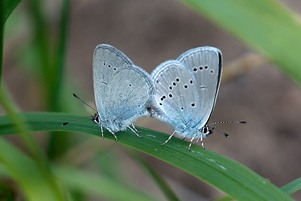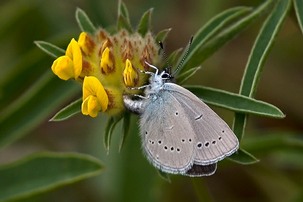

Biodiversity
Action
Plan
Small Blue is a very small butterfly, in fact the smallest in the UK, Inconspicuous and easily overlooked, fluttering and low in flight; the moving dots of colour are a delightful sight.
Small Blue colonies up and down the UK are declining fast. It is only known in Barnsley in a small area near its northern boundary.
Small Blue Cupido minimus
UKBAP priority species
S41 Species of Principal Importance.
Red List: Near Threatened.
Butterfly Conservation: Medium Priority
Schedule 5 Wildlife & Countryside Act
Protection
As a species of principal importance, the presence of Small Blue needs to be taken into consideration for conservation by any public body when performing its functions.
This includes avoiding sites with a colony for development and promoting their conservation and enhancement.
In Barnsley a site with a Small Blue colony is of sufficient priority to be designated a Local Wildlife Site.
Local Wildlife Sites have a presumption against development but no protection against operations that do not require planning or change of use consent.
Small Blue has legal protection against sale under Schedule 5 of the Wildlife and Countryside Act (1981)
For more information:
Butterfly Conservation: Small Blue
UK Butterflies Small Blue
Local Priority Habitats: Open Mosaic on Previously Developed Land; Built Environment: Brownfield Sites.

They typically form small, discrete colonies. Extremely sedentary, adults rarely fly further than 40 metres from where they were born but in exceptional hot years will disperse over a few hundred metres.
Small Blues favour sheltered, south-facing sites with sparse grassland.
Sparse or eroding vegetation is necessary for Kidney Vetch, their sole larval foodplant, to become established and be sustained. Adults nectar on Kidney Vetch or Bird’s Foot Trefoil.
These conditions are found on previously developed land in Barnsley that has poor, disturbed sandy or limestone soils.
Males competing for females gather in ‘leks’ in open grassland close to landmarks such as bushes or trees. Usually there is one generation a year, with adults usually flying from mid May to early July. In hot summers there may be a partial second brood in August.

Small Blues have smoky black (male) or dark brown (female) upper wings and silvery-blue undersides with small black spots on pale blue/grey background, reminiscent of a small Holly Blue.
Males have a dusting of blue scales on the upper side.
Eggs are laid singly, tucked into young, partially open flower heads of Kidney Vetch.
Larvae feed on the developing flowers and then seeds. They pass the winter in soil crevices or under moss and pupate the following spring at ground level.

Conservation: Maintain a high density of Kidney Vetch in a mosaic of short and tall vegetation with some patches of light scrub. As Kidney Vetch is short-lived and easily out-competed by more vigorous plants, regular creation of sparsely vegetated swards is required to enable seedlings to (re)establish.
Small Blue butterfly